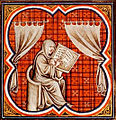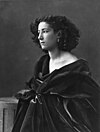Portal:Biography
The Biography Portal
A biography, or simply bio, is a detailed description of a person's life. It involves more than just basic facts like education, work, relationships, and death; it portrays a person's experience of these life events. Unlike a profile or curriculum vitae (résumé), a biography presents a subject's life story, highlighting various aspects of their life, including intimate details of experience, and may include an analysis of the subject's personality.
Biographical works are usually non-fiction, but fiction can also be used to portray a person's life. One in-depth form of biographical coverage is called legacy writing. Works in diverse media, from literature to film, form the genre known as biography.
An authorized biography is written with the permission, cooperation, and at times, participation of a subject or a subject's heirs. An autobiography is written by the person themselves, sometimes with the assistance of a collaborator or ghostwriter. (Full article...)
Featured biographies –
Sir Robert William Robson CBE (18 February 1933 – 31 July 2009) was an English footballer and football manager. His career included periods playing for and later managing the England national team and being a UEFA Cup-winning manager at Ipswich Town.
Robson's professional playing career as an inside forward spanned nearly 20 years, during which he played for three clubs: Fulham, West Bromwich Albion, and, briefly, Vancouver Royals. He also made 20 appearances for England, scoring four goals. After his playing career, he found success as both a club and international manager, winning league championships in both the Netherlands and Portugal, earning trophies in England and Spain, and taking England to the semi-finals of the 1990 FIFA World Cup, which remained the national team's best run in a World Cup since 1966 until they reached the semi-finals of the 2018 World Cup. His last management role was as a mentor to the manager of the Republic of Ireland national team, while his final official club job was at boyhood club Newcastle United, whom he left in 2004. He held several managerial positions outside of England, most notably one year at Barcelona in 1996–97, as well as stints at PSV, Sporting CP and Porto. (Full article...)
Urse built the earliest form of Worcester Castle in Worcester, which encroached on the cathedral cemetery there, earning him a curse from the Archbishop of York. Urse helped to put down a rebellion against King William I in 1075, and quarrelled with the Church in his county over the jurisdiction of the sheriffs. He continued in the service of William's sons after the king's death, and was appointed constable under William II and marshal under Henry I. Urse was known for his acquisitiveness, and during William II's reign was considered second only to Ranulf Flambard, another royal official, in his rapacity. Urse's son succeeded him as sheriff but was subsequently exiled, thus forfeiting the office. Through his daughter, Urse is an ancestor of the Beauchamp family, who eventually became Earls of Warwick. (Full article...)
David Gallaher (30 October 1873 – 4 October 1917) was an Irish-born New Zealand rugby union footballer best remembered as the captain of the "Original All Blacks"—the 1905–06 New Zealand national team, the first representative New Zealand side to tour the British Isles. Under Gallaher's leadership the Originals won 34 out of 35 matches over the course of tour, including legs in France and North America; the New Zealanders scored 976 points and conceded only 59. Before returning home he co-wrote the classic rugby text The Complete Rugby Footballer with his vice-captain Billy Stead. Gallaher retired as a player after the 1905–06 tour and took up coaching and selecting; he was a selector for both Auckland and New Zealand for most of the following decade.
Born in Ramelton, Ireland, Gallaher migrated to New Zealand with his family as a small child. After moving to Auckland, in 1895 he joined Ponsonby RFC and was selected for his province in 1896. In 1901–02 he served with the New Zealand Contingent in the Anglo–Boer War. He first appeared on the New Zealand national team for their unbeaten tour of Australia in 1903, and played in New Zealand's first ever Test match, against Australia in Sydney. The Originals Gallaher captained during 1905–06 helped to cement rugby as New Zealand's national sport, but he was relentlessly pilloried by the British press for his role as wing-forward. The use of a wing-forward, which critics felt was a tactic to deliberately obstruct opponents, contributed to decades of strain between the rugby authorities of New Zealand and the Home Nations; the International Rugby Football Board (IRFB) effectively outlawed the position in 1931. (Full article...)
Mary Jane Richardson Jones (c. 1819 – December 26, 1909) was an American abolitionist, philanthropist, and suffragist. Born in Tennessee to free African-American parents, Jones and her family moved to Illinois. With her husband, John, she was a leading African-American figure in the early history of Chicago. The Jones household was a stop on the Underground Railroad and a center of abolitionist activity in the pre-Civil War era, helping hundreds of fugitive slaves flee slavery.
After her husband's death in 1879, Jones continued to support African-American civil rights and advancement in Chicago, and became a suffragist. Jones was active in the women's club movement and mentored a new generation of younger black leaders, such as Fannie Barrier Williams and Ida B. Wells. Historian Wanda A. Hendricks has described her as a wealthy "aristocratic matriarch, presiding over the [city's] black elite for two decades." (Full article...)
Menkauhor Kaiu (also known as Ikauhor and in Greek as Mencherês, Μεγχερῆς) was an Ancient Egyptian pharaoh of the Old Kingdom period. He was the seventh ruler of the Fifth Dynasty at the end of the 25th century BC or early in the 24th century BC (circa 2399–2390 BC).
Menkauhor ruled for possibly eight or nine years, following king Nyuserre Ini, and was succeeded in turn by Djedkare Isesi. Although Menkauhor is well attested by historical sources, few artefacts from his reign have survived. Consequently, his familial relation to his predecessor and successor is unclear, and no offspring of his have been identified. Khentkaus III may have been Menkauhor's mother, as indicated by evidence discovered in her tomb in 2015. (Full article...)
Prince Octavius of Great Britain (23 February 1779 – 3 May 1783) was the thirteenth child and eighth son of King George III and his queen consort, Charlotte of Mecklenburg-Strelitz. Six months after the death of his younger brother Prince Alfred, Octavius was inoculated against the smallpox virus. Several days later, he became ill. His subsequent death at the age of four devastated his parents, and in particular his father. King George III had been very fond of his two youngest sons, Alfred and Octavius, and his later bouts of madness involved hallucinations of them. (Full article...)
Harold Tommy Amaker Jr. (/ˈæməkər/; born June 6, 1965) is an American college basketball coach and the head coach of the Harvard University men's basketball team. He has also coached for the University of Michigan and Seton Hall University. He played point guard and later served as an assistant coach at Duke University under Mike Krzyzewski. An All-American player, Amaker set numerous records and earned many honors and awards. He took Seton Hall to the post season in each of his four seasons as their coach, helped Michigan win the National Invitation Tournament the year after a probationary ban from postseason play, and had the three highest single-season win totals in the history of Harvard basketball, the school's first six Ivy League championships and first NCAA tournament victory.
Amaker was a high school basketball star at Wilbert Tucker Woodson High School from 1979 to 1983 under coach Paul (Red) Jenkins. Amaker led the Woodson Cavaliers to four straight Northern District titles, including victories over the national powerhouse DeMatha Catholic High School. A McDonald's All-American, Amaker also earned the Wooden Defensive Player of the Year award in 1983, awarded to the nation's best high school defensive player. He averaged almost 18 points, and contributed 7.5 assists and 3.5 steals per game while at Woodson. In December 1992, the Connection named Amaker to the Connection Dream Team, as a point guard.McDonald's All-American and a Parade All-American. As a college basketball player, he set most of the assists records and many steals records for Duke basketball. He also set the Atlantic Coast Conference single-season games played and games started records. Among his numerous accolades, he was the first winner of the NABC Defensive Player of the Year, and he was a third team All-American. (Full article...)















































